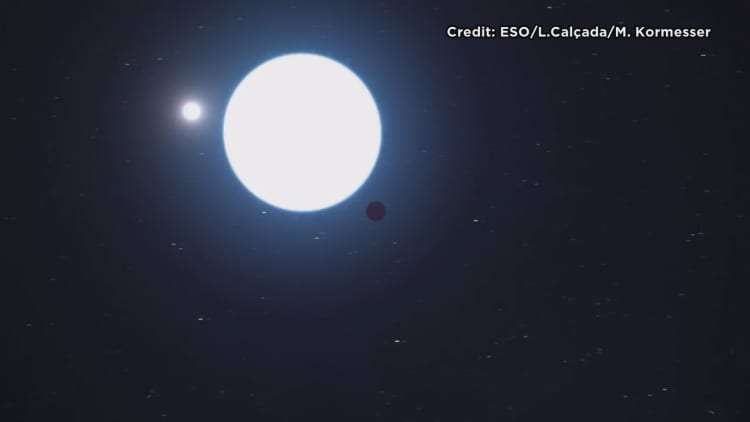
Astronomers have discovered a large Jupiter-like planet doing an unusual dance with three suns, hundreds of light years away from us.
The planet they have found is challenging beliefs about the conditions necessary for planets to form or orbit stars. It is unlike any other seen: a massive planet on an extremely wide orbit in system with multiple stars.
Made of gas and four times the size of Jupiter, it orbits the largest of its three suns every 550 years or so, and that long period is divided into two seasons: one where its three suns rise and set everyday, and another season with continuous sunlight.
The video above shows an artist's depiction what the researchers say is "unlike any other known system," in a paper published Thursday in the journal Science.
The planet known as "HD 131399Ab" orbits the largest star in the system, and just beyond that, the two smaller stars twirl around each other as they too slowly orbit the largest star. This is a highly unusual arrangement, and it challenges some of the ideas scientists had about how exoplanets form.
For one thing, the planet is twice as far from the star it orbits as Pluto is from our own sun, which is not a particularly favorable place for a planet to be. Its orbit is so wide — and so close to the two smaller stars —the planet is in a region that is thought to be too unstable to support an orbiting planet. In fact it is almost far enough to be "kicked out" of its system. It could still become unstable enough to be kicked out in the future.
The team, led by University of Arizona researcher Kevin Wagner, discovered the system using imaging techniques made possible with the SPHERE instrument and the Very Large Telescope in Chile's Atacama desert.
"It is not clear how this planet ended up on its wide orbit in this extreme system, and we can't say yet what this means for our broader understanding of the types of planetary systems out there, but it shows there is more variety out there than many would have deemed possible," Wagner said in a press release. "What we do know is that planets in multi-star systems are much less explored, and potentially just as numerous as planets in single-star systems."
The researchers suggest the planet could have formed through three likely scenarios: it could have formed around the largest star it currently orbits, but been pushed out to its great distance through some sort of scattering event; it could have formed around one of the smaller stars, but collided with another planet, or the smaller stars could have pushed the planet into the biggest star's orbit. It is also possible that the stars were arranged differently, and have just changed their positions.
Such multi-star systems are actually quite common, but they have not been places where astronomers have looked for exoplanets. This may be the first of many such discoveries in systems with two or more suns.


